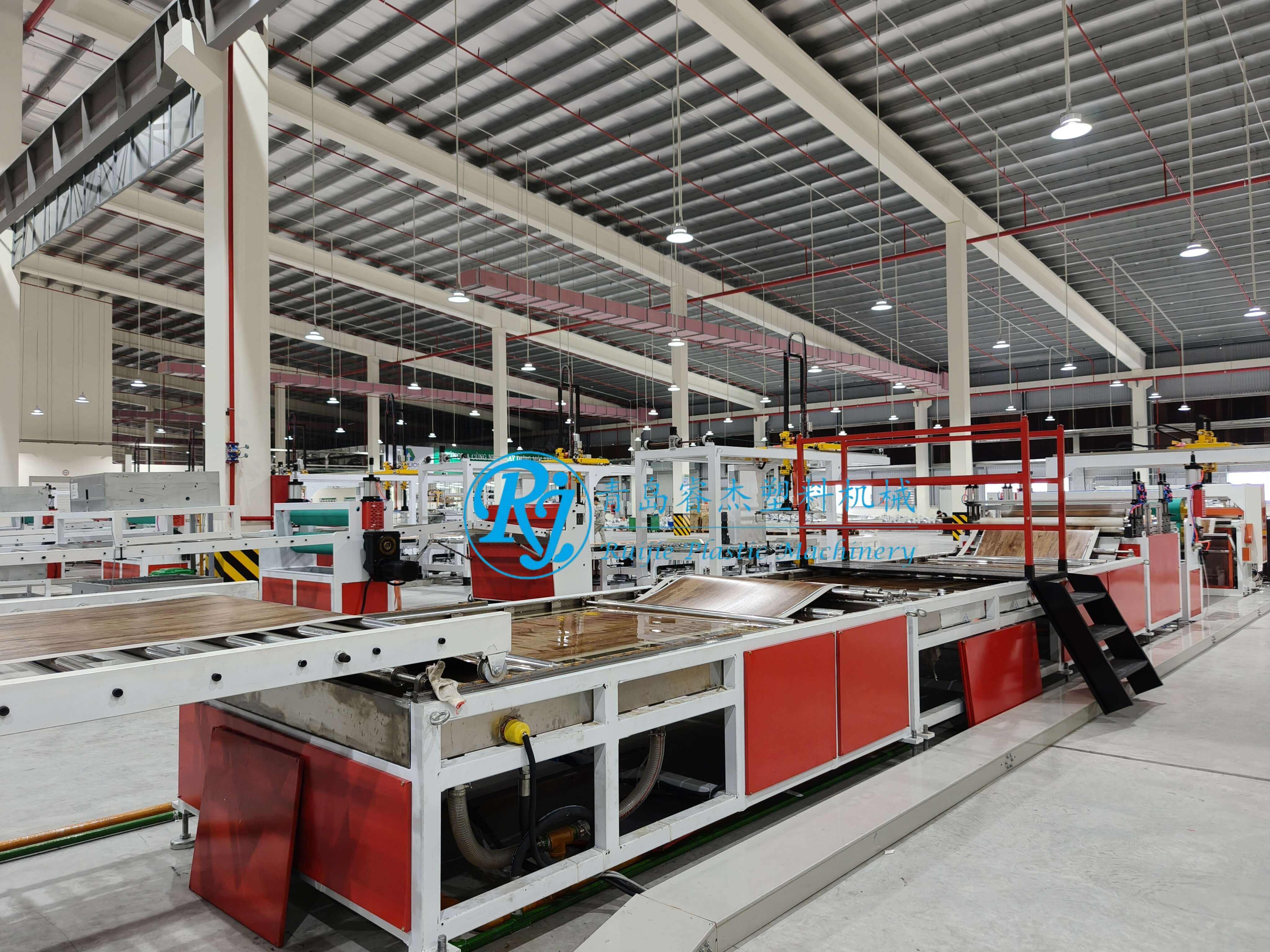ສ່ວນປະກອບຫຼັກຂອງສາຍຜົນ SPC/LVT Floor Production Lines
ລະບົບປະສົມສຽງສໍາລັບຄວາມແນວໜ້າ
ການໄດ້ສ່ວນປະສົມທີ່ຖືກຕ້ອງມີຄວາມສຳຄັນຫຼາຍໃນການຜະລິດຜະລິດຕະພັນພື້ນ SPC ແລະ LVT ເນື່ອງຈາກການປະສົມສ່ວນປະກອບຜິດພາດສາມາດເຮັດໃຫ້ບໍລິເວນທັງໝົດເສຍຫາຍໄປ. ອຸປະກອນປະສົມໃໝ່ໆໃນປັດຈຸບັນເຊັ່ນເຄື່ອງປະສົມຄວາມເຄັ່ງດັນສູງ (high shear mixers) ແລະ ເຄື່ອງປະສົມລວງ (batch mixers) ຊ່ວຍໃຫ້ສາມາດຜະລິດວັດສະດຸທີ່ມີຄວາມສອດຄ່ອງທົ່ວເຖິງ, ເຊິ່ງເຮັດໃຫ້ຜົນຕ່າງກັນຫຼາຍໃນການປະຕິບັດງານຂອງຜະລິດຕະພັນສຳເລັດຮູບ. ສ່ວນຫຼາຍລະບົບທີ່ມີຄຸນນະພາບດີຈະຍຶດໝັ້ນໃນມາດຕະຖານອຸດສາຫະກຳໃນການເລືອກວັດສະດຸ, ເຊິ່ງໃນຄວາມເປັນຈິງແລ້ວຊ່ວຍປະຢັດເວລາໃນຂະບວນການຜະລິດ. ຕົວຢ່າງເຊັ່ນເຄື່ອງປະສົມຄວາມເຄັ່ງດັນສູງ ສາມາດປະສົມສ່ວນປະກອບໃຫ້ແຜ່ກະຈາຍຢ່າງຖືກຕ້ອງໃນທົ່ວສານປະສົມ ເຮັດໃຫ້ແຕ່ລະແຜ່ນອອກມາດຽວກັນທັງຮູບລັກສະນະ ແລະ ຄຸນນະພາບການໃຊ້ງານ. ແຕ່ໃນດ້ານກົງກັນຂ້າມ, ຖ້າມີບັນຫາໃດໆເກີດຂຶ້ນໃນຂະນະປະສົມ ບໍລິສັດຈະສິ້ນເຊີງດ້ວຍການຜະລິດແຜ່ນບົກເບີດ, ວັດຖຸດິບສູນເສຍ ແລະ ບັນຫາດ້ານການເງິນຢ່າງຮ້າຍແຮງໃນໄລຍະຍາວ. ນັ້ນເປັນເຫດຜົນທີ່ຜູ້ຜະລິດທີ່ສະຫຼາດຍິນດີຈ່າຍເງິນເພີ່ມເຕີມເພື່ອລະບົບປະສົມທີ່ດີຂຶ້ນບໍ່ພຽງແຕ່ເພື່ອຫຼີກລ່ຽງບັນຫາຕ່າງໆເທົ່ານັ້ນ ແຕ່ຍັງເພື່ອຮັກສາຂະບວນການຜະລິດໃຫ້ດຳເນີນໄປຢ່າງລຽນສະຫຼາດໂດຍບໍ່ມີການຢຸດຊົ່ວຄາວຕະຫຼອດເວລາ.
ໜ່ວງປະສານແລະການຄຸ້ມຄົງອຸນຫະພູມ
ຫົກໜ່ວຍອອກແບບຍັງຄົງເປັນສິ່ງສຳຄັນໃນການຜະລິດທັງວັດສະດຸປູພື້ນ SPC ແລະ LVT ຜ່ານຂະບວນການອອກແບບເອງ. ການໄດ້ຜົນໄດ້ເງິນຂື້ນກັບວິທີທີ່ວັດສະດຸໄຫຼເຂົ້າໄປໃນເຄື່ອງຈັກ ແລະ ລາຍລະອຽດຂອງຮູບຮ່າງທາງເລຂາຄະນິດທີ່ກຳນົດຮູບຮ່າງໃຫ້ເຂົາເຈົ້າຢ່າງຖືກຕ້ອງ. ການຮັກສາອຸນຫະພູມໃຫ້ຄົງທີ່ພາຍໃນເຄື່ອງຈັກເຫຼົ່ານີ້ມີຄວາມສຳຄັນຫຼາຍ, ໂດຍສະເພາະສຳລັບວັດສະດຸທີ່ສາມາດແຍກຕົວໄດ້ງ່າຍເມື່ອຖືກເຮັດໃຫ້ຮ້ອນ. ເທກໂນໂລຊີໃໝ່ໆ ເຊັ່ນ: ການຕັ້ງຄ່າອອກແບບຊັ້ນຫຼາຍຊັ້ນ ນຳເອົາບາງສິ່ງບາງຢ່າງທີ່ແຕກຕ່າງມາສູ່ໂຕະສຳລັບຜູ້ຜະລິດທີ່ກຳລັງຊອກຫາການແຂ່ງຂັນ. ເມື່ອໂຮງງານຈັດການອຸນຫະພູມໃຫ້ຖືກຕ້ອງ, ພວກເຂົາເຈົ້າຈະເຫັນຂະບວນການຜະລິດທີ່ໄວຂື້ນ, ວັດສະດຸເສຍຫຼຸດລົງ ແລະ ຄ່າໃຊ້ຈ່າຍດ້ານພະລັງງານຕ່ຳລົງໂດຍລວມ. ທັງໝົດນີ້ຊີ້ໃຫ້ເຫັນເຖິງເຫດຜົນທີ່ວ່າການຄວບຄຸມຄວາມຮ້ອນໃຫ້ຖືກຕ້ອງບໍ່ພຽງແຕ່ສຳຄັນເທົ່ານັ້ນ ແຕ່ຍັງຈຳເປັນຕໍ່ການຜະລິດພື້ນທີ່ມີຄຸນນະພາບໂດຍບໍ່ຕ້ອງໃຊ້ເງິນຫຼາຍໃນຕົ້ນທຶນການຜະລິດ.
ເทັກນິກ Calendering ແລະ Embossing
ຂະບວນການຄາລິດເດີ້ງ (calendering) ແມ່ນມີບົດບາດສຳຄັນໃນການກຳນົດວ່າພື້ນ SPC ແລະ LVT ຈະຫນາແລະມີເນື້ອຜິວແບບໃດ. ໂດຍບໍ່ມີຂະບວນການຄາລິດເດີ້ງທີ່ເໝາະສົມ, ຜູ້ຜະລິດຈະບໍ່ສາມາດບັນລຸລັກສະນະພາຍນອກແລະຄຸນສົມບັດການໃຊ້ງານທີ່ລູກຄ້າຄາດຫວັງຈາກແກ້ໄຂບັນຫາພື້ນໃນຍຸກທັນສະໄໝໄດ້. ຕໍ່ມາກໍມີຂະບວນການປັ້ມລາຍ (embossing) ທີ່ເຮັດໃຫ້ສິ່ງຕ່າງໆດີຂຶ້ນໄປອີກ. ມັນເພີ່ມລາຍລະອຽດແລະຮູບແບບຕ່າງໆທີ່ສົນໃຈຕາເມື່ອຕິດຕັ້ງໃນເຮືອນ ຫຼື ພື້ນທີ່ທາງການຄ້າ. ຜູ້ຜະລິດທີ່ລົງທຶນໃນເຄື່ອງຈັກຄາລິດເດີ້ງທີ່ດີຂຶ້ນ ແລະ ເຕັກນິກການປັ້ມລາຍທີ່ສ້າງສັນ ມັກຈະດຶງດູດຄວາມສົນໃຈໃນຕະຫຼາດ. ພວກເຮົາໄດ້ເຫັນເຫດການນີ້ເກີດຂຶ້ນຫຼາຍຄັ້ງກັບບໍລິສັດຕ່າງໆທີ່ປັບປຸງເຄື່ອງຈັກຂອງພວກເຂົາ ແລະ ສັງເກດເຫັນການປັບປຸງທີ່ແທ້ຈິງໃນການປຽບທຽບຜະລິດຕະພັນຂອງພວກເຂົາກັບຄູ່ແຂ່ງ. ການຄວບຄຸມຄຸນນະພາບໃນຂະບວນການເຫຼົ່ານີ້ໃຫ້ແໜ້ນກໍສຳຄັນຫຼາຍ. ຄວາມບໍ່ສອດຄ່ອງນ້ອຍໆໃນຄວາມເລິກຂອງລາຍພິມ ຫຼື ຄຸນນະພາບຂອງພື້ນຜິວສາມາດເຮັດໃຫ້ຜະລິດຕະພັນທີ່ດີເບິ່ງຄືວ່າບໍ່ດີ, ສະນັ້ນຜູ້ຜະລິດສ່ວນຫຼາຍຈຶ່ງສ້າງຂັ້ນຕອນກວດກາຫຼາຍຂັ້ນຕອນໃນຂະບວນການຜະລິດເພື່ອຮັກສາມາດຕະຖານໃນທຸກໆລໍ້ຜະລິດ.
ອຸປະກອນການຕັດແລະປັກກັນ
ການຕັດທີ່ຖືກຕ້ອງໃນສາຍຜະລິດ SPC ແລະ LVT ມີຄວາມສຳຄັນຫຼາຍໃນການຮັກສາຄວາມຖືກຕ້ອງສູງທີ່ຕ້ອງການສຳລັບຜະລິດຕະພັນທີ່ມີຄຸນນະພາບ. ນັ້ນເປັນເຫດຜົນທີ່ສະຖານທີ່ຜະລິດສ່ວນຫຼາຍຈຶ່ງລົງທຶນໃນເຄື່ອງຈັກຕັດທີ່ມີຄວາມແທດທີ່ສູງສຳລັບຂັ້ນຕອນນີ້. ໃນເລື່ອງລະບົບການຫຸ້ມຫໍ່, ການນຳເອົາເຕັກໂນໂລຊີອັດຕະໂນມັດເຂົ້າມາໃຊ້ງານແທ້ໆແລ້ວຊ່ວຍເຮັດໃຫ້ຂະບວນການໄວຂຶ້ນ ແລະ ຫຼຸດຜ່ອນຄ່າໃຊ້ຈ່າຍໃນການຈ້າງງານດ້ວຍມື. ພວກເຮົາເຫັນຜູ້ຜະລິດຫຼາຍຂຶ້ນເລີ່ມໃຊ້ເຕັກໂນໂລຊີຕັດດ້ວຍເລເຊີພ້ອມກັບແຂນຫຸ້ນຍົນໃນຂະບວນການຜະລິດຂອງເຂົາເຈົ້າ. ຫຼັງຈາກທີ່ເຊື່ອມໂຍງເຕັກໂນໂລຊີເຫຼົ່ານີ້ເຂົ້າກັບຂັ້ນຕອນການຕັດ ແລະ ການຫຸ້ມຫໍ່ແລ້ວ, ປະສິດທິພາບກໍ່ເພີ່ມຂຶ້ນຢ່າງຊັດເຈນ. ຂໍ້ມູນການດຳເນີນງານທີ່ແທ້ຈິງໃນໂຮງງານສະແດງໃຫ້ເຫັນວ່າຂະບວນການຕັດ ແລະ ຫຸ້ມຫໍ່ທີ່ດີຂຶ້ນບໍ່ພຽງແຕ່ຫຼຸດຜ່ອນເວລາການຈັດສົ່ງຄຳສັ່ງເທົ່ານັ້ນ, ແຕ່ຍັງເພີ່ມຄວາມພໍໃຈຂອງລູກຄ້າຂຶ້ນອີກດ້ວຍ, ໃນຂະນະທີ່ຄ່າໃຊ້ຈ່າຍໃນການດຳເນີນງານກໍ່ຫຼຸດລົງຫຼາຍ. ບັນດາບໍລິສັດທີ່ເລີ່ມໃຊ້ເຕັກໂນໂລຊີທີ່ທັນສະໄໝເຫຼົ່ານີ້ກ່ອນໜ້າອື່ນໆ ສ່ວນຫຼາຍລາຍງານວ່າຂະບວນການຜະລິດຂອງເຂົາເຈົ້າສັ້ນລົງຢ່າງຊັດເຈນ ແລະ ອັດຕາກຳໄລກໍ່ເພີ່ມຂຶ້ນຫຼາຍ, ເຊິ່ງເປັນຂໍ້ໄດ້ປຽບໃນການແຂ່ງຂັນທີ່ສຳຄັນໃນສະພາບແວດລ້ອມການຜະລິດທີ່ແຂ່ງຂັນກັນສູງໃນປັດຈຸບັນ.
ປິນຫາກະຈາຍໃນການເລືອກເສັ້ນຜ່ານການຜະລິດ
ການສອບສວນຂອງຂະໜາດເຮືອນແຮ່ ແລະ ຄວາມຕ້ອງການຂອງຜົນຜະລິດ
ການໄດ້ຮັບຂະໜາດທີ່ເໝາະສົມສຳລັບໂຮງງານຜະລິດ ແລະ ການຄິດໄລ່ວ່າຈະຕ້ອງຜະລິດຫຍັງແດ່ ແມ່ນສິ່ງສຳຄັນຫຼາຍໃນການຕັ້ງຄ່າແຖວຜະລິດ SPC/LVT. ແຖວຜະລິດຈະຕ້ອງສອດຄ່ອງກັບພື້ນທີ່ທີ່ມີຢູ່ໃນໂຮງງານ ແລະ ປະລິມານການຜະລິດຕໍ່ມື້ທີ່ຕ້ອງການ. ໃນການຄາດຄະເນປະລິມານຜົນຜະລິດທີ່ຕ້ອງການ, ການເບິ່ງສິ່ງທີ່ລູກຄ້າຕ້ອງການໃນຕະຫຼາດແມ່ນເປັນເຫດຜົນທີ່ດີ, ແຕ່ຢ່າລືມກວດເບິ່ງສິ່ງທີ່ໂຮງງານສາມາດຈັດການໄດ້ພາຍໃນຕົວມັນເອງ. ສິ່ງຕ່າງໆເຊັ່ນ: ອັດຕາການຜະລິດຜ່ານລະບົບ (throughput) ແລະ ປະລິມານຂອງເສຍໃນຂະນະຜະລິດ ສາມາດບອກເຖິງປະສິດທິພາບຂອງການດຳເນີນງານໃນຂະໜາດໂຮງງານທີ່ກຳນົດໄດ້. ຄຳນຶງເຖິງມາດຕະຖານຂອງອຸດສາຫະກຳ - ແຖວຜະລິດຂະໜາດນ້ອຍທີ່ຜະລິດປະມານ 500 ຫາ 800 ຫົວໜ່ວຍຕໍ່ມື້ ມັກຈະຕ້ອງການການຕັ້ງຄ່າທີ່ແຕກຕ່າງກັນຢ່າງສິ້ນເຊີງເມື່ອທຽບກັບສະຖານທີ່ຜະລິດຂະໜາດໃຫຍ່ທີ່ສັ່ງທຳເອງ. ສິ່ງນີ້ໝາຍເຖິງການໃຊ້ເວລາໃນການວິເຄາະປັດໃຈຕ່າງໆເຫຼົ່ານີ້ຢ່າງລະອຽດກ່ອນທີ່ຈະລົງທຶນໃນຂະນະທີ່ແນ່ໃຈວ່າຊັບພະຍາກອນຖືກຈັດສັນຢ່າງເໝາະສົມ ແລະ ບໍ່ເສຍເງິນກັບອຸປະກອນທີ່ບໍ່ຈຳເປັນ.
ระดับการอัตโนมัติและการผสานเทคโนโลยี
ເມື່ອເບິ່ງເຖິງການນຳໃຊ້ລະບົບອັດຕະໂນມັດໃນສາຍການຜະລິດ SPC/LVT, ຜູ້ຜະລິດຈຳເປັນຕ້ອງຄຳນຶງເຖິງຂັ້ນຕ່າງໆ ເຊິ່ງລວມມື້ແຕ່ການດຳເນີນງານທີ່ເປັນອັດຕະໂນມັດທັງໝົດ ໄປຈົນເຖິງການຕັ້ງຄ່າແບບດ້ວຍມືບາງສ່ວນ. ປະໂຫຍດຫຼັກຂອງການນຳໃຊ້ລະບົບອັດຕະໂນມັດລວມມີການປະຢັດເງິນເດືອນ, ຄວາມແນ່ນອນໃນການຜະລິດທີ່ດີຂື້ນ ແລະ ການເຮັດໃຫ້ສະຖານທີ່ເຮັດວຽກປອດໄພຍິ່ງຂື້ນໂດຍລວມ. ແຕ່ການນຳເອົາເອົາອົງປະກອບເຕັກໂນໂລຊີ Industry 4.0 ທີ່ທັນສະໄໝເຊັ່ນ ເຊັນເຊີ IoT ແລະ ລະບົບ AI ມາໃຊ້ບໍ່ໄດ້ງ່າຍເໝືອນກັນ. ການເຊື່ອມໂຍງອົງປະກອບເຫຼົ່ານີ້ໃຫ້ເຮັດວຽກຮ່ວມກັນຢ່າງລຽນລ້ອມຍັງຄົງເປັນສິ່ງທ້າທາຍໃຫຍ່ຫຼວງສຳລັບໂຮງງານຫຼາຍແຫ່ງ. ຕາມການສຶກສາຕ່າງໆໃນອຸດສາຫະກຳ, ບໍລິສັດທີ່ລົງທຶນໃນລະບົບອັດຕະໂນມັດມັກຈະເຫັນວ່າຜົນຜະລິດການຜະລິດເພີ່ມຂື້ນໃນຂະນະທີ່ຄ່າໃຊ້ຈ່າຍຫຼຸດລົງ. ຍົກຕົວຢ່າງເຊັ່ນ ສາຍການຫຸ້ມຫໍ່ – ໂຮງງານບາງແຫ່ງສາມາດຫຼຸດຜ່ອນຄ່າໃຊ້ຈ່າຍດ້ານແຮງງານໄດ້ປະມານ 60% ຫຼັງຈາກນຳໃຊ້ວິທີແກ້ໄຂອັດຕະໂນມັດ. ຜົນໄດ້ຮັບຈາກໂລກຈິງເຫຼົ່ານີ້ສະແດງໃຫ້ເຫັນເຖິງເຫດຜົນທີ່ຜູ້ຜະລິດຫຼາຍຄົນກຳລັງພິຈາລະນາລະບົບອັດຕະໂນມັດຢ່າງຈິງຈັງ ເຖິງແມ່ນວ່າຈະຕ້ອງລົງທຶນເບື້ອງຕົ້ນກໍຕາມ.
ປະກັນຕົວຕາມສານຍະນິຕິໆສາກົນ
ການປະຕິບັດຕາມມາດຕະຖານການຜະລິດສາກົນເປັນສິ່ງສຳຄັນຫຼາຍສຳລັບບໍລິສັດໃນຂະແໜງ SPC/LVT ຖ້າພວກເຂົາຕ້ອງການສະໜອງຜະລິດຕະພັນທີ່ປອດໄພ ແລະ ມີຄຸນນະພາບສູງ. ສະຖາບັນຕ່າງໆ ເຊັ່ນ ISO ແລະ ASTM ກຳນົດກົດລະບຽບທີ່ມີຜົນກະທົບຢ່າງໃຫຍ່ຫຼວງຕໍ່ການຂາຍຜະລິດຕະພັນໃນຕະຫຼາດໂລກ. ສຳລັບຜູ້ຜະລິດ, ການປະຕິບັດຕາມມາດຕະຖານເຫຼົ່ານີ້ໝາຍເຖິງຄວາມສາມາດໃນການຜະລິດສິນຄ້າຢ່າງຕໍ່ເນື່ອງໃນແຕ່ລະລ້າຊຸດໂດຍບໍ່ມີການຫຼຸດລົງຂອງຄຸນນະພາບ. ພວກຜູ້ເຂົ້າໃນອຸດສະຫະກຳເຕືອນເຖິງຜົນສະເພາະທີ່ເກີດຂຶ້ນເມື່ອບໍລິສັດຂ້າມຂັ້ນຕອນການກວດກາຄວາມຖືກຕ້ອງ. ມີບາງເຫດການທີ່ໂຮງງານຕ້ອງປະເຊີນໜ້າກັບຄ່າປັບໝິນທີ່ສູງ, ຕ້ອງຈ່າຍພາສີນຳເຂົ້າ ຫຼື ບໍ່ສາມາດຂາຍສິນຄ້າໃນບາງປະເທດເນື່ອງຈາກບໍ່ຜ່ານການກວດກາ. ການເບິ່ງຂໍ້ມູນຕະຫຼາດທີ່ແທ້ຈິງຍັງສະແດງໃຫ້ເຫັນບາງສິ່ງທີ່ໜ້າສົນໃຈ. ບໍລິສັດທີ່ປະຕິບັດຕາມມາດຕະຖານເຫຼົ່ານີ້ມັກສາມາດສ້າງຄວາມສຳພັນທີ່ດີຂຶ້ນກັບລູກຄ້າໃນໄລຍະຍາວ. ຜະລິດຕະພັນຂອງພວກເຂົາໄດ້ຮັບການຍອມຮັບໃນດ້ານຄວາມສາມາດເຊື່ອຖືໄດ້ ເຊິ່ງເຮັດໃຫ້ພວກເຂົາແຕກຕ່າງຈາກຄູ່ແຂ່ງທີ່ຕັດສັ້ນວິທີການ. ສິ່ງນີ້ເຮັດໃຫ້ເກີດຂໍ້ໄດ້ປຽບໃນທຸລະກິດທີ່ແທ້ຈິງໃນຕະຫຼາດສາກົນທີ່ແອອັດ.
ການ Thai ນິວຫຼາຍການສຸກສາຫຼັງຈາກການຂາຍ
ການສະໜັບສະໜູນຫຼັງການຂາຍທີ່ດີແມ່ນມີຄວາມສຳຄັນຫຼາຍໃນການໃຊ້ງານສາຍການຜະລິດ SPC ແລະ LVT ໃຫ້ເຕັມປະໂຫຍດໃນໄລຍະຍາວ. ສິ່ງທີ່ດີທີ່ສຸດແມ່ນຫຍັງ? ການຝຶກອົບຮົມທີ່ມີປະສິດທິພາບແທ້ໆ, ການກວດສອບເປັນປະຈຳເພື່ອຮັກສາການດຳເນີນງານໃຫ້ລຽບຮ້ອຍ, ພ້ອມທັງມີການເຂົ້າເຖິງຊິ້ນສ່ວນສຳຮອງໄດ້ຢ່າງງ່າຍດາຍເວລາຕ້ອງການ. ຕ້ອງການຮູ້ບໍ່ວ່າການສະໜັບສະໜູນດີປານໃດ? ກະລຸນາເບິ່ງຄຳເຫັນຂອງລູກຄ້າທີ່ຂຽນໄວ້ໃນອິນເຕີເນັດ. ຕົວເລກກໍບໍ່ມີການຫຼອກລວງເຊັ່ນກັນ - ບໍລິສັດທີ່ມີໂຄງການສະໜັບສະໜູນທີ່ເຂັ້ມແຂງມັກຈະມີການຢຸດເຊົາການດຳເນີນງານໜ້ອຍລົງ ແລະ ດຳເນີນການໂດຍລວມໄດ້ດີຂຶ້ນ. ກະລຸນາເບິ່ງບົດຄົດເຮົາຈາກຜູ້ຜະລິດ ແລະ ທ່ານຈະເຫັນແບບແຜນທີ່ຊັດເຈນລະຫວ່າງໂຄງສ້າງການສະໜັບສະໜູນທີ່ເຂັ້ມແຂງກັບລູກຄ້າທີ່ພໍໃຈ ແລະ ຢູ່ກັບບໍລິສັດໃນໄລຍະຍາວ. ເມື່ອທຸລະກິດໃຫ້ຄວາມສຳຄັນກັບການບໍລິການຫຼັງການຂາຍທີ່ເຊື່ອຖືໄດ້, ພວກເຂົາບໍ່ພຽງແຕ່ຫຼຸດຜ່ອນການຢຸດເຊົາທີ່ມີຄ່າໃຊ້ຈ່າຍແພງແຕ່ຍັງແກ້ໄຂບັນຫາໄດ້ໄວຂຶ້ນ, ຊຶ່ງໝາຍຄວາມວ່າສາຍການຜະລິດສາມາດດຳເນີນໄປຢ່າງຕໍ່ເນື່ອງໂດຍບໍ່ມີການລົບກວນ ແລະ ສາມາດໃຫ້ຜົນໄດ້ຮັບໄດ້ທຸກໆປີ.
ແນວໃນການເລືອກ SPC/ ເສັ້ນຜ່ານການຜະລິດพື້ນ LVT ສຳລັບເຮືອນໜ້າ
ໃນການເລືອກສາຍພາລະກິດຜະລິດພື້ນ SPC/LVT, ຜູ້ຜະລິດຈະຕ້ອງຄຳນຶງເຖິງບາງສິ່ງຫຼາຍຢ່າງກ່ອນ. ພື້ນທີ່ທີ່ມີຢູ່ສຳລັບການຕິດຕັ້ງ, ລະດັບຜົນຜະລິດທີ່ຄາດໄວ້, ແລະ ລັກສະນະດ້ານເຕັກໂນໂລຊີທີ່ຕ້ອງການ ທັງໝົດນີ້ມີຜົນຕໍ່ຂະບວນການຕັດສິນໃຈ. ລະຫວ່າງບັນດາບໍລິສັດໃນຂະແໜງການນີ້, Qingdao Ruijie Plastic Machinery ໄດ້ສ້າງຊື່ສຽງທີ່ແຂງແຮງໃນໄລຍະຫຼາຍປີທີ່ດຳເນີນທຸລະກິດ. ພວກເຂົາສະເໜີເຄື່ອງຈັກທີ່ໃຊ້ງານໄດ້ດີໃນໂຮງງານຜະລິດ, ບໍ່ແມ່ນແຕ່ເຄື່ອງຈັກທີ່ເບິ່ງດີແຕ່ບໍ່ໄດ້ໃຊ້ງານ. ສິ່ງທີ່ເຮັດໃຫ້ພວກເຂົາແຕກຕ່າງແມ່ນຄວາມສາມາດໃນການຈັດການທຸກຢ່າງຈາກການດຳເນີນງານຂະໜາດນ້ອຍຈົນເຖິງການຜະລິດໃນຂະໜາດໃຫຍ່ໂດຍບໍ່ມີການ compromise ໃນທັງສອງດ້ານ. ຍົກຕົວຢ່າງເຊັ່ນ ລະບົບການຄລຸກຂອງພວກເຂົາ ທີ່ປັດຈຸບັນໄດ້ກາຍເປັນມາດຕະຖານໃນຫຼາຍສະຖານທີ່ຍ້ອນມັນໃຊ້ງານໄດ້ຢ່າງເຊື່ອຖືຕະຫຼອດເວລາ. ນອກຈາກນັ້ນ, ຫົວໜ່ວຍການອັດອັດຂອງພວກເຂົາຍັງປະກອບມີລະບົບຄວບຄຸມທີ່ທັນສະໄໝທີ່ບັນດາຄູ່ແຂ່ງຍັງບໍ່ທັນທັນໃນປັດຈຸບັນ. ບໍລິສັດຍັງສະໜອງການຊ່ວຍເຫຼືອໃນໂລກຈິງ, ຊ່ວຍໃຫ້ລູກຄ້າສາມາດປັບແຕ່ງສາຍການຜະລິດໃຫ້ເໝາະກັບຄວາມຕ້ອງການຂອງເຂົາເຈົ້າ. ບັນດາບໍລິສັດຫຼາຍແຫ່ງລາຍງານວ່າມີການປັບປຸງທີ່ສຳຄັນໃນປະສິດທິພາບຂອງຂະບວນການເຮັດວຽກເມື່ອຍ້າຍມາໃຊ້ເຄື່ອງຈັກຂອງ Qingdao Ruijie, ນອກຈາກນັ້ນຜະລິດຕະພັນຍັງອອກມາດີຂຶ້ນ ແລະ ສອດຄ່ອງກັບມາດຕະຖານຂອງອຸດສາຫະກຳທີ່ເຂັ້ມງວດຢ່າງຕໍ່ເນື່ອງ.
ການວິເຄາະຄ່າໃຊ້ຈ່າຍແລະການແຜນການລົງທຶນ
ຄ່າທຶນຕົ້ນສຳລັບການຜະລິດທີ່ຕ່າງກັນ
ການຕັ້ງຄ່າແຖວຜະລິດ SPC/LVT ມາພ້ອມກັບລາຄາທີ່ແຕກຕ່າງກັນຂຶ້ນຢູ່ກັບຈຳນວນຜະລິດຕະພັນທີ່ຕ້ອງການຜະລິດຕໍ່ມື້. ການດຳເນີນງານຂະໜາດນ້ອຍທີ່ຜະລິດປະມານ 500 ຫາ 800 ຕາແມັດຕໍ່ມື້ໂດຍທົ່ວໄປແລ້ວມີຄ່າໃຊ້ຈ່າຍຢູ່ລະຫວ່າງ 680,000 ໂດລາສະຫະລັດ ຫາ 1,200,000 ໂດລາສະຫະລັດ ເພື່ອເລີ່ມຕົ້ນ. ເມື່ອຂະຫຍາຍການຜະລິດເປັນຂະໜາດກາງປະມານ 1,500-2,000 ຕາແມັດຕໍ່ມື້ ຜູ້ຜະລິດຄວນຄາດໝາຍວ່າຈະລົງທຶນຢູ່ລະຫວ່າງ 1,800,000 ແລະ 2,800,000 ໂດລາສະຫະລັດ. ສ່ວນໃຫຍ່ທີ່ຢາກຜະລິດຫຼາຍກວ່າ 3,000 ຕາແມັດຕໍ່ມື້ຕ້ອງປະເຊີນໜ້າກັບຄ່າໃຊ້ຈ່າຍທີ່ສູງຂຶ້ນເຊິ່ງເຄີຍມີມູນຄ່າຫຼາຍກວ່າ 3,500,000 ໂດລາສະຫະລັດສຳລັບແຖວຜະລິດທີ່ສັ່ງທຳ. ການຄິດໄລ່ຕົວເລກເຫຼົ່ານີ້ໃຫ້ຖືກຕ້ອງມີຄວາມສຳຄັນຫຼາຍຍ້ອນວ່າເງິນທີ່ລົງທຶນໃນເບື້ອງຕົ້ນຈະກຳນົດວ່າບໍລິສັດຈະໄດ້ກຳໄລໃນອະນາຄົດຫຼືບໍ່. ການເບິ່ງເງິນທີ່ໃຊ້ຈ່າຍທັງໝົດລວມທັງອຸປະກອນ, ການຕິດຕັ້ງຕັ້ງຄ່າແລະການຝຶກອົບຮົມພະນັກງານ ຈະຊ່ວຍໃຫ້ຜູ້ຜະລິດເຂົ້າໃຈໄດ້ຊັດເຈນຂຶ້ນເມື່ອສ້າງແຜນການເງິນຂອງພວກເຂົາ. ຕົວຢ່າງຈາກໂລກຄວາມເປັນຈິງສະແດງໃຫ້ເຫັນວ່າບໍລິສັດທີ່ວາງແຜນຢ່າງລະມັດລະວັງມັກຈະຂະຫຍາຍໂຕໄດ້ໄວຂຶ້ນ ແລະ ດຳເນີນທຸລະກິດໄດ້ດົນກ່ວາບໍລິສັດທີ່ດຳເນີນການຢ່າງຮີບດ່ວນໂດຍບໍ່ໄດ້ກຽມພ້ອມໃຫ້ດີເທົ່າທີ່ຄວນ.
ປົນຫຼິ້ນຄ່າໃຊ້ຈ່າຍໃນອາຍຸການຜະລິດທາງຍາວ
ຫຼັງຈາກທີ່ບໍລິສັດໄດ້ເປີດສາຍການຜະລິດແລ້ວ, ພວກເຂົາຕ້ອງປະເຊີນກັບການໃຊ້ຈ່າຍຕ່າງໆ ທີ່ເຮັດໃຫ້ຜົນກໍາໄລຫຼຸດລົງ. ຄິດເຖິງສິ່ງຕ່າງໆ ເຊັ່ນ ຄ່າຈ້າງສໍາລັບຄົນງານ, ວຽກງານບໍາລຸງຮັກສາປົກກະຕິ, ວັດຖຸດິບທີ່ຈໍາເປັນໃນແຕ່ລະມື້, ບວກກັບຄ່າໄຟຟ້າທີ່ເພີ້ມຂຶ້ນ. ຄ່າໃຊ້ຈ່າຍນ້ອຍໆທັງຫຼາຍນີ້ ເກັບມາເປັນເວລາຫລາຍເດືອນ ແລະຫລາຍປີ, ສົ່ງຜົນກະທົບຢ່າງຮ້າຍແຮງຕໍ່ຜົນໄດ້ຮັບທີ່ຍັງເຫຼືອ. ຍົກຕົວຢ່າງການຜະລິດພື້ນທີ່ SPC ຕົວຢ່າງບັນຊີພະລັງງານເທົ່ານັ້ນ ແມ່ນປ່ຽນແປງຢ່າງຫຼວງຫຼາຍ ອີງຕາມວ່າເຄື່ອງຈັກເກົ່າແກ່ຫຼືມີປະສິດທິພາບເທົ່າໃດ. ຜູ້ຜະລິດທີ່ສະຫຼາດ ຊອກຫາວິທີທີ່ຈະຕັດແຈກແຈກບ່ອນນີ້ບ່ອນນັ້ນ ໂດຍບໍ່ເສຍຄ່າຄຸນນະພາບຂອງຜະລິດຕະພັນ. ການເບິ່ງວ່າ ພືດອື່ນໆທີ່ປະສົບຜົນສໍາເລັດນັ້ນ ເຮັດແນວໃດຊ່ວຍຫຼາຍ. ໂຮງງານບາງແຫ່ງປະຢັດເງິນໂດຍການປັບປຸງເຄື່ອງຈັກພຽງເຄື່ອງດຽວ ໃນຂະນະທີ່ໂຮງງານອື່ນໆເຈລະຈາລາຄາທີ່ດີກວ່າກັບຜູ້ສະ ຫນອງ. ສິ່ງສໍາຄັນແມ່ນການຊອກຫາຈຸດທີ່ດີເລີດ ທີ່ໃຊ້ຈ່າຍຫນ້ອຍກວ່າ ບໍ່ໄດ້ຫມາຍຄວາມວ່າ ຈະຜະລິດຜະລິດຕະພັນທີ່ຮ້າຍແຮງກວ່າ
ຄ່າໃຊ້ຈ່າຍທີ່ບໍ່ເຫັນໃນການຜະລິດ SPC/LVT
ໃນການຕັ້ງງົບປະມານສໍາລັບແຖວຜະລິດ SPC/LVT, ຜູ້ຜະລິດຫຼາຍຄົນມັກລືມຄ່າໃຊ້ຈ່າຍເພີ່ມເຕີມທີ່ບໍ່ສົງໃສທີ່ເກີດຂຶ້ນໃນເວລາຕໍ່ມາ. ສິ່ງຕ່າງໆເຊັ່ນຄ່າທໍານຽມຄວາມສອດຄ່ອງ, ຄ່າຊໍາລະເຊິ່ງບໍ່ຄາດຄິດ, ແລະ ຄວາມບົກຜ່ອງໃນຫາງຈ່າຍມັກຈະສົ່ງຜົນກະທົບຕໍ່ງົບປະມານຫຼາຍກ່ວາທີ່ຄາດໄວ້. ພິຈາລະນາເບິ່ງການປະຕິບັດຕາມລະບຽບການເຊັ່ນກັນ - ການບໍ່ສາມາດບັນລຸມາດຕະຖານທ້ອງຖິ່ນອາດຈະຫມາຍເຖິງການຈ່າຍເງິນຫຼາຍພັນໂດລາໃນຮູບແບບຄ່າປັບໃໝ້ ຫຼື ຄ່າພາສີນໍາເຂົ້າ. ຄວາມລົ້ມເຫຼວຂອງອຸປະກອນກໍເປັນອີກບັນຫາໜຶ່ງ. ເຄື່ອງຈັກທີ່ເສຍຫຼືເກີດບັນຫາຢ່າງແທ້ຈິງຫມາຍເຖິງການຊໍາລະສຸກເສີນ, ການສູນເສຍເວລາໃນໂຮງງານຜະລິດ, ແລະ ສຸດທ້າຍກໍເຮັດໃຫ້ກໍາໄລຫຼຸດລົງ. ບໍລິສັດທີ່ສະຫຼາດຈະສ້າງແຜນສໍາຮອງໄວ້ໃນຂະບວນການງົບປະມານຕັ້ງແຕ່ມື້ທໍາອິດ. ພວກເຂົາເຈົ້າເບິ່ງຂໍ້ມູນໃນອະດີດ, ພົບປະສົນທະນາກັບຜູ້ສະໜອງ, ແລະ ຄິດໄລ່ເງິນສໍາຮອງໄວ້ສໍາລັບສະພາວະສຸກເສີນ. ລາຍງານຂອງອຸດສາຫະກໍາສະແດງໃຫ້ເຫັນວ່າມີບໍລິສັດຫຼາຍແຫ່ງທີ່ເດືອດຮ້ອນເມື່ອພວກເຂົາບໍ່ໄດ້ຄິດເຖິງແຫຼ່ງທີ່ເຮັດໃຫ້ເງິນສົດຫຼຸດລົງຢ່າງລັບໜັກເຫຼົ່ານີ້. ການຈັດງົບປະມານທີ່ຖືກຕ້ອງບໍ່ແມ່ນພຽງການຄິດເລກເທິງເຈ້ຍເທົ່ານັ້ນ, ແຕ່ເປັນການກ້າວໄປຂ້າງໜ້າກ່ອນທີ່ບັນຫາຈະກາຍເປັນວິກິດການ.
ການແຍກແຕກຈາກກຸ່ມທີ່ມີຂໍ້ຜິດພາດທົ່ວໄປໃນການເລືອກເສັ້ນ
ບໍ່ພິຈາລະນາການປະກັບປະກົນ
ໃນການເລືອກສາຍການຜະລິດ SPC/LVT, ຜູ້ຜະລິດຫຼາຍຄົນມັກຈະລືມເອົາໃຈໃສ່ຕໍ່ກົດລະບຽບຂອງລັດຖະບານ, ເຊິ່ງສຸດທ້າຍກາຍເປັນໜຶ່ງໃນບັນດາເງື່ອນໄຂສໍາຄັນທີ່ບໍ່ຄວນລືມ. ການຍຶດໝັ້ນຕາມກົດລະບຽບໝາຍເຖິງການປະຕິບັດຕາມກົດໝາຍໃນຂະນະຜະລິດ ແລະ ຫຼີກລ່ຽງຄ່າປັບໃໝທີ່ແພງ. ບໍລິສັດທີ່ບໍ່ສົນໃຈຕໍ່ຂໍ້ກໍານົດເຫຼົ່ານີ້ ອາດຈະຕ້ອງປະເຊີນໜ້າກັບຜົນສະເພາະຮ້າຍແຮງເຊັ່ນ: ກັກເງິນພາສີນໍາເຂົ້າ. ຕົວຢ່າງເຊັ່ນ: ອຸປະກອນທີ່ບໍ່ສອດຄ່ອງກັບມາດຕະຖານໃນເອີຣົບຈະຖືກເກັບຄ່າທໍານຽມເພີ່ມປະມານ 15% ຫາ 20% ຕາມມາດຕະຖານເຄມີ REACH. ຜູ້ປຶກສາສ່ວນຫຼາຍທີ່ພວກເຮົາສົນທະນາກັບເນັ້ນເຖິງຄວາມສໍາຄັນຂອງການຮູ້ຢ່າງແຈ່ມແຈ້ງກ່ຽວກັບຄວາມສອດຄ່ອງໃນແຕ່ລະຕະຫຼາດທີ່ຜະລິດຕະພັນຈະຖືກຂາຍ. ນອກຈາກການຖືກຈັບກຳລັງຜິດກົດໝາຍແລ້ວ, ການບໍ່ສອດຄ່ອງຍັງສົ່ງຜົນເສຍຕໍ່ພາບລວມຂອງຍີ່ຫໍ້ ແລະ ສ້າງຄວາມສ່ຽງດ້ານການເງິນໃຫ້ບໍລິສັດ. ຖ້າເບິ່ງຂໍ້ມູນຈາກໂລກຄວາມເປັນຈິງ, ບໍລິສັດທີ່ບໍ່ປະຕິບັດຕາມກົດລະບຽບຈະຕ້ອງຈ່າຍເງິນຫຼາຍກ່ວາຄ່າປັບໃໝທີ່ຖືກກໍານົດ. ພວກເຂົາຍັງຕ້ອງປະເຊີນໜ້າກັບການຊັກຊ້າໃນການຜະລິດ ແລະ ຄ່າໃຊ້ຈ່າຍທີ່ບໍ່ຄາດຄິດ, ສິ່ງເຫຼົ່ານີ້ທັງໝົດສົ່ງຜົນໃຫ້ກໍາໄລຫຼຸດລົງຢ່າງຫຼວງຫຼາຍ.
ການ ເສຍ ສະລະ ຄຸນ ນະພາ ບ ເພື່ອ ຄ່າ ໃຊ້ ຈ່າຍ ໃນ ເບື້ອງ ຕົ້ນ ທີ່ ຕ່ໍາ ກວ່າ
ການຫຼຸດທາງລັດໃນວັດຖຸດິບ ແລະ ອຸປະກອນເພື່ອປະຢັດເງິນໃນທຳອິດ ທຳດຽວເບິ່ງຄືວ່າດີ, ແຕ່ບໍລິສັດມັກຈະຕ້ອງຈ່າຍເງິນຫຼາຍໃນພາຍຫຼັງເມື່ອຜົນຕອບແທນຂອງຜະລິດຕະພັນບໍ່ດີພໍ ແລະ ລູກຄ້າເລີ່ມຕັ້ງຄຳຖາມກ່ຽວກັບຄວາມສາມາດເຊື່ອຖືໄດ້ຂອງຍີ່ຫໍ້. ພິຈາລະນາເຄື່ອງອັດເປັນຕົວຢ່າງທີ່ຜູ້ຜະລິດຫຼາຍຄົນປະເຊີນໜ້າ. ຮຸ່ນທີ່ລາຄາຖືກກ່ວາອາດປະຢັດໄດ້ປະມານ $50k ໃນເບື້ອງຕົ້ນ, ແຕ່ເຄື່ອງເຫຼົ່ານີ້ມັກຈະຜະລິດຂໍ້ບົກພ່ອງຫຼາຍຂຶ້ນປະມານ 18% ໃນໄລຍະຍາວ. ນັ້ນໝາຍຄວາມວ່າການແກ້ໄຂບັນຫາເຫຼົ່ານັ້ນຈະເສຍຄ່າໃຊ້ຈ່າຍຫຼາຍກ່ວາເງິນທີ່ປະຢັດໄດ້ໃນຕອນເລີ່ມຕົ້ນ. ທຸກຄົນທີ່ເອົາໃຈໃສ່ໃນການດຳເນີນທຸລະກິດທີ່ມີກຳໄລຕ້ອງເບິ່ງເກີນກ່ວາລາຄາ. ຄຸນນະພາບມີຄວາມສຳຄັນຍ້ອນວ່າມັນສົ່ງຜົນກະທົບຕໍ່ທຸກຢ່າງຕັ້ງແຕ່ກຳໄລຂອງບໍລິສັດຈົນເຖິງຕຳແໜ່ງຂອງບໍລິສັດໃນຕະຫຼາດ. ພວກເຮົາໄດ້ເຫັນຫຼາຍໆສະຖານະການທີ່ບໍລິສັດເລືອກເອົາຂໍ້ສະເໜີຕ່ຳສຸດ ແຕ່ຫຼັງຈາກນັ້ນກໍພົບວ່າຕ້ອງໃຊ້ເງິນເພີ່ມເຕີມໃນການຊ່ວຍແກ້ໄຂ, ເຄື່ອງທີ່ຕ້ອງປ່ຽນໃໝ່ ແລະ ຈັດການກັບລູກຄ້າທີ່ບໍ່ສາມາດເຊື່ອໝັ້ນໃນຄວາມອາດທົນຖາວອນຂອງຜະລິດຕະພັນໄດ້ອີກຕໍ່ໄປ. ຄະນິດສາດບໍ່ສາມາດຄິດໄດ້ເມື່ອຊື່ສຽງຂອງຍີ່ຫໍ້ຖືກທຳລາຍແບບນັ້ນ.
ການລືມການປັບປຸງການຈັດວາງໂຮງງານ
ການຈัดແບ່ງພື້ນທີ່ໂຮງງານໃຫ້ຖືກຕ້ອງນັ້ນມີຄວາມສຳຄັນຫຼາຍຕໍ່ການເພີ່ມປະສິດທິພາບໃນການຜະລິດ ແລະ ຄວາມສະໝໍ່າສະເໝີໃນການຂົນສົ່ງວັດຖຸດິບໃນຂະບວນການຜະລິດ SPC/LVT. ເມື່ອໂຮງງານຈັດແບ່ງພື້ນທີ່ບໍ່ດີ, ສິ່ງຕ່າງໆກໍເລີ່ມມີບັນຫາຢ່າງໄວວາກ. ພວກເຮົາໄດ້ເຫັນຫຼາຍໆກໍລະນີທີ່ການອອກແບບພື້ນທີ່ບໍ່ດີເຮັດໃຫ້ເກີດຈຸດອ່ອນໃນຂະບວນການຜະລິດ, ເຊິ່ງເປັນເຫດຜົນໃຫ້ເວລາລໍຖ້າລະຫວ່າງຂັ້ນຕອນຕ່າງໆຍາວນານຂຶ້ນ. ຜູ້ຊໍານິຊໍານານສ່ວນຫຼາຍແນະນຳໃຫ້ພິຈາລະນາຢ່າງລະອຽດກ່ຽວກັບການນຳໃຊ້ພື້ນທີ່ ແລະ ຮັບປະກັນວ່າແຕ່ລະຂັ້ນຕອນໃນຂະບວນການຜະລິດເຊື່ອມຕໍ່ກັນຢ່າງຖືກຕ້ອງ. ບໍລິສັດທີ່ໃຊ້ເວລາໃນການຄິດໄລ່ພື້ນທີ່ໂຮງງານໃໝ່ມັກຈະເຫັນການປັບປຸງທີ່ແທ້ຈິງໃນຜົນຜະລິດ. ບາງລາຍງານໃນອຸດສາຫະກຳໄດ້ກ່າວເຖິງການປັບປຸງປະສິດທິພາບການຜະລິດສູງຂຶ້ນປະມານ 15 ຫາ 20 ເປີເຊັນຫຼັງຈາກມີການປ່ຽນແປງພື້ນທີ່, ບໍ່ພຽງແຕ່ເປັນຕົວເລກທີ່ດີໃນເຈ້ຍເທົ່ານັ້ນ ແຕ່ຍັງສາມາດປະຕິບັດໄດ້ຈິງ ແລະ ຊ່ວຍໃຫ້ຜູ້ຜະລິດປະຢັດຄ່າໃຊ້ຈ່າຍ ແລະ ຫຼຸດເວລາການດຳເນີນງານໄດ້ເມື່ອພວກເຂົາລົງທຶນໃນການວາງແຜນແຕ່ຕົ້ນ.
